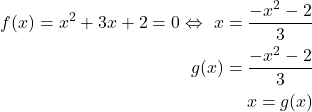In this numerical computing tutorial, we explain the basics of the fixed point iteration for solving nonlinear equations. We also explain how to implement the fixed point iteration in Python for solving nonlinear equations. The motivation for studying the fixed point iteration comes from the fact that this algorithm is the basis of a number of numerical algorithms used in control engineering, linear algebra, machine learning, etc. The YouTube tutorial is given below.
Basics of the Fixed Point Iteration
Fixed point iteration is a simple method for solving nonlinear equations. Consequently, it is very easy to implement this method in Python or in some other programming languages. It has a scalar and matrix form. In this tutorial, we explain the scalar form of the fixed point iterations.
The goal is to solve a nonlinear equation
(1) ![]()
where ![]() is a (nonlinear) function of
is a (nonlinear) function of ![]() .
.
For example, we want to solve these equations:
(2) 
Instead of directly solving (1), we instead solve an equivalent problem
(3) ![]()
where ![]() is a (nonlinear) function of
is a (nonlinear) function of ![]() . We can always transform the problem (1) into the problem (3). Consider this example
. We can always transform the problem (1) into the problem (3). Consider this example
(4) 
Then, consider this example
(5) 
Here, it should be kept in mind that the form of the equation ![]() is not unique. It is a matter of experience to find an appropriate form of
is not unique. It is a matter of experience to find an appropriate form of ![]() . Different forms of
. Different forms of ![]() will produce different convergence results.
will produce different convergence results.
Now we are ready to define the fixed point.
Definition of the fixed point: The value ![]() that satisfies this equation
that satisfies this equation
(6) ![]()
is called the fixed point of ![]() . Since the expression (6) is obtained from the nonlinear equation
. Since the expression (6) is obtained from the nonlinear equation ![]() , the fixed point is also the solution of the equation
, the fixed point is also the solution of the equation
(7) ![]()
The fixed point iteration is a method for iteratively computing the fixed point ![]() that satisfies (6). The fixed point iteration algorithm approximates the fixed point by propagating the fixed point iteration:
that satisfies (6). The fixed point iteration algorithm approximates the fixed point by propagating the fixed point iteration:
(8) ![]()
where for ![]() the iteration is initialized with an initial guess
the iteration is initialized with an initial guess ![]() selected by the user. For sufficiently large
selected by the user. For sufficiently large ![]() ,
, ![]() approximates the fixed point
approximates the fixed point ![]() .
.
The main questions are
- When we can use the fixed point iteration to approximate the solution?
- What are the conditions that the function
 needs to satisfy such that the fixed point iteration converges?
needs to satisfy such that the fixed point iteration converges?
Conditions on the function g(x) such that the fixed point iteration converges: Let us assume that
- The function
 is continuously differentiable on some interval
is continuously differentiable on some interval ![Rendered by QuickLaTeX.com [a,b]](https://aleksandarhaber.com/wp-content/ql-cache/quicklatex.com-fcda5ef4ae327e1afef79dc73df91703_l3.png) .
. - The function
 is such that
is such that ![Rendered by QuickLaTeX.com g(x)\in [a,b]](https://aleksandarhaber.com/wp-content/ql-cache/quicklatex.com-d606cf4f960587943351df60a561bed6_l3.png) for
for ![Rendered by QuickLaTeX.com \forall x\in [a,b]](https://aleksandarhaber.com/wp-content/ql-cache/quicklatex.com-676a263a86a2c51f661206fffa3578b6_l3.png) .
. - There exists a constant
 , such that
, such that  and such that
and such that
(9) ![]()
That is, the constant ![]() is a constant that bounds the first derivative of
is a constant that bounds the first derivative of ![]() .
.
Then, the series of points ![]() generated by the fixed point iteration (8) converge to the fixed point
generated by the fixed point iteration (8) converge to the fixed point ![]() for any initial guess
for any initial guess ![]() in the interval
in the interval ![]() . Furthermore,
. Furthermore, ![]() .
.
Python Implementation of the Fixed Point Iteration
Here, we present a Python implementation of the fixed point iteration. The convergence error is measured by
(10) ![]()
As a demonstration, we consider the following example:
(11) ![]()
We consider the two forms of the function
(12) ![]()
and
(13) ![]()
The accuracy of the final value is measured by computing
(14) ![]()
The closer the value ![]() to zero, the more accurate the solution is.
to zero, the more accurate the solution is.
The Python implementation of the fixed point iteration is given below.
# -*- coding: utf-8 -*-
"""
Python implementation of the fixed point iteration
Author: Aleksandar Haber
"""
import numpy as np
# f function
def fFunction(x):
y=x**2+3*x+2
return y
# g function
# first version
def gFunction(x):
y=(1/3)*(-x**2-2)
return y
# g function
# second version
def gFunction2(x):
y=-np.sqrt(-3*x-2)
return y
# function implementing the fixed point iteration
def fixedPointIteration(gF,initialGuess, toleranceError =10**(-6), maxIteration=1000):
#iteration
k=0
# initialize the iteration
x_k=initialGuess
# initialize the error
error=1000
print("Iteration no: ", k, "** x= ", x_k)
while(k<maxIteration and error>toleranceError):
# fixed point iteration
x_kp1=gF(x_k)
error=np.abs(x_kp1-x_k)
# update the variables
x_k=x_kp1
k=k+1
print("Iteration no: ", k, "** x= ",x_k)
return x_kp1
# initial guess
x0= -1.5
# max number of iteration
maxIterationNumber=500
# tolerance error
tE=10**(-5)
# First g function
solution=fixedPointIteration(gFunction,x0, tE, maxIterationNumber)
# value of the function f
fFunction(solution)
# Second g function
# initial guess
x0= -1.2
solution2=fixedPointIteration(gFunction2,x0, tE, maxIterationNumber)
# value of the function f
fFunction(solution2)